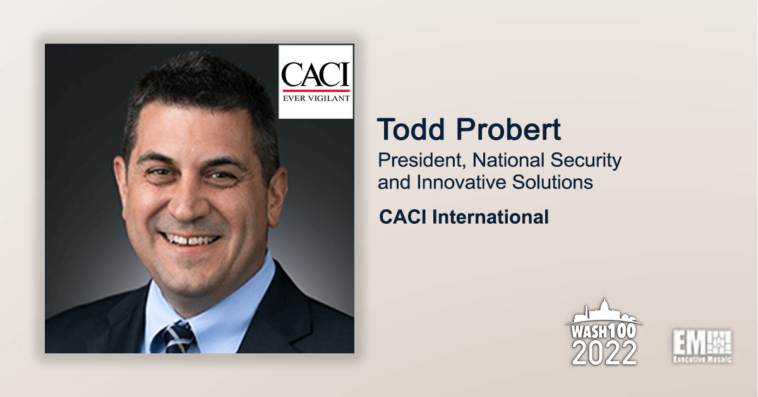Todd Probert, president of National Security and Innovative Solutions at CACI as well as a 2022 Wash100 Award recipient, recently spoke with ExecutiveBiz about the recent acquisition of SA Photonics and its benefit to the company’s growth initiatives and customer satisfaction.
In addition, the two-time Wash100 Award winner also discussed the new growth markets that CACI is looking to move into over the coming year as well as how the company sets itself apart in the federal landscape through a long history of driving innovation, during the latest Executive Spotlight interview.
“We are always keeping an eye on refining our go-to-market approach, ensuring that we’re focusing on the most important things that drive our national security programs. That means regularly looking at our business processes, technology portfolio and talent. Those are the key ingredients to ensure we keep innovating and growing.”
You can read the full interview with Todd Probert below:
ExecutiveBiz: What can you tell us about your time at CACI so far, the company’s recent growth initiatives and how you’re driving value for customers across the federal sector?
Todd Probert: “My time at CACI has been a fantastic ride so far. I’m impressed every day by the breadth and depth of our technology. Most importantly, I love working with our dedicated and mission-driven team. We have some of the smartest people working on the toughest challenges, and it’s great to see their commitment to the national security mission front and center every day.
It’s been a tough few years for most of us with the pandemic, of course. We’ve come through a lot of change, and in parallel, we have seen a rapid evolution of the threat environment. We are all witnessing the continued digitization of the multi-domain battlefield that is driving the need for smarter, more agile technology to pace the threats.
Our mission expertise and technical heritage has positioned us well to respond with a full portfolio of exquisite technology solutions for almost any mission in any environment. As the threat dynamics emerge, we have really focused in on the three areas of electronic warfare, cybersecurity, and resilient technology for the space domain.
The common thread between these is the employment of strategic software – what we call mission software – to affect everything from sensing to acting.
This has taken shape as a portfolio of software-defined capability for customer missions that incorporate our solid foundation in modern software practices and architectures, combined with decades of expertise. We took our heritage in enterprise workflow automation and applied it to mission needs at the edge.
At the same time, we expanded our footprint in open architecture solutions, working with some of the most critical weapon systems and software programs, and we’ve ramped up our truly agnostic portfolio that makes the best use of capabilities.
We have been looking deeper into artificial intelligence and machine learning, as well as how we can push that technology out to edge processes versus apply it to cloud processing and spending a lot of time addressing security and what it means for the edge versus the cloud. So truly our decades of expertise in enterprise IT and mission support inform our technology portfolio, and we are already seeing some great gains.
Software-driven capability is an area I’ve been passionate about for a long time, and the momentum is growing for more agile, rapid capability. CACI sets itself apart with a heritage of innovation and our strategy of investing ahead of need. This allows us to build better and meet the mission at the speed of relevance.”
ExecutiveBiz: What are you focused on for the coming year? What do you hope to accomplish and are there any new markets that you’re keeping an eye on?
Todd Probert: “We are always keeping an eye on refining our go-to-market approach, ensuring that we’re focusing on the most important things that drive our national security programs. That means regularly looking at our business processes, technology portfolio and talent. Those are the key ingredients to ensure we keep innovating and growing.
For decades CACI has been at the leading edge of space domain technology – from mission planning and responsive launch to advanced communications, photonics, sensing, and space systems exploitation.
Our teams have developed and delivered an end-to-end portfolio of technology for our customers. In recent years, we have seen a massive shift from space being an uncontested domain into an area where space protection, technology diversification, and resiliency is paramount.
We are well-positioned to support this transformation, leveraging some of the fantastic accomplishments in foreign signals exploitation and intelligence gathering we have made over the last 20 to 30 years. This has been one of the big drivers of our focus on software, while our mission support in data processing has informed our approach for moving forward.
We’ve also had some customer investment and research and development in alternative precision navigation and timing (PNT). Today, the world has the luxury of using GPS for timing and navigation.
As we look harder at resiliency, we aligned our resources with our customer strategies and started to craft timing solutions for space payloads. Timing is key for defense, intelligence and civilian space missions, and we have real alternative solutions that are being developed, tested, and launched into space in just a few short months.
We developed space capability payloads using software-defined radios that we are launching on a demonstration satellite (DemoSat) in early 2023. The DemoSat is testing and demonstrating both APNT and Tactical ISR mission payloads on this upcoming launch, but with the software-defined hardware, we can program capability into many different architectures that have only been envisioned on a drawing board thus far. We are committed to taking that leap forward and investing ahead of need.
CACI also has several ground-based surveillance processing technologies. We’re looking to take those payloads into space as well and know that we have a good breakout market on our hands. CACI is one of very few companies with the technical edge and encryption capabilities that scale into the space domain.
In a more traditional sense, we are also suppliers of launch support and training for NASA and other commercial launch providers. It has been exciting to be a part of the civilian missions and expansion into lunar base activities and beyond.
We know how critical resiliency and secure communications are to these missions, and we have a lot of new innovations and technology to bring to this market. It’s going to be a fantastic year for us.”
ExecutiveBiz: What can you tell us about your recent acquisition of SA Photonics and how they’ve benefited your portfolio, and driven value for your company and customers?
Todd Probert: “The acquisition of SA Photonics was the latest event in a continuing strategy for us. CACI has been a leader in photonics capabilities for some time, several decades in fact, and with our previous acquisition of LGS Innovations, this area has become the single fastest-growing business segment for our space resiliency portfolio.
The SA Photonics team brings unique technology expertise, mission support, and high-volume manufacturing skills to CACI’s photonics team. The expertise from both groups brings a rare synergy of research and development innovation in optical communications to our customers.
This acquisition will address a much broader market going forward, from high-end manned flight programs to the value-based proliferated LEO market that the Space Development Agency and Space Force are seeking. And our advantage is that we are now the only US-based provider of advanced photonics engineering that can also provide high-volume manufacturing capability.
Our photonics technology has the core capability to transform communications and resiliency across the space domain, but also has usability across the other contested domains. There are separate air, ground, and maritime photonics solutions all built with the same building blocks.
There are obviously things you need to do differently in each domain, but there’s so much potential for growth in these areas. The SA Photonics acquisition was fantastic for us, and we see a great future in this field for CACI.”





